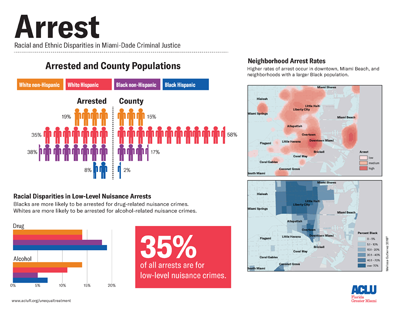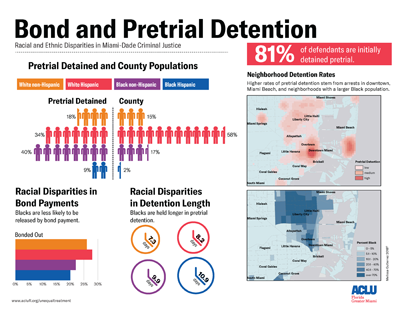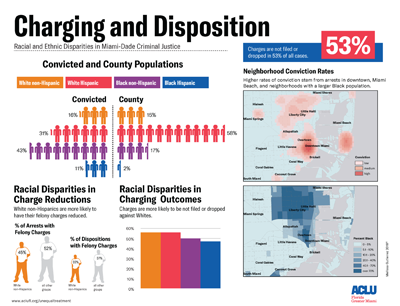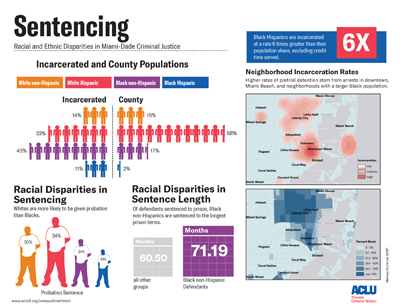
Unequal Treatment: Racial and Ethnic Disparities in Miami-Dade Criminal Justice
Analyzing data on all adult criminal defendants from 2010 to 2015, we examined individual and neighborhood racial and ethnic disparities across multiple decision points within Miami-Dade County’s criminal justice system: arrest, bond and pretrial detention, charging and disposition, and sentencing.
In our new report, Unequal Treatment: Racial and Ethnic Disparities in Miami-Dade Criminal Justice, our analysis uncovered racial and ethnic disparities at each of these decision points. We also found disparities at every decision point that, regardless of ethnicity, result in disadvantages for Black defendants and neighborhoods while resulting in advantages for White defendants and neighborhoods. This report demonstrates that race and ethnicity shape Miami-Dade County’s criminal justice system. Race and ethnicity shape a person’s involvement in the criminal justice system and in the system’s outcomes.
Unequal Treatment is the most comprehensive study of its kind looking at recent criminal justice data in Miami-Dade County. The report is a joint effort of the ACLU of Florida and its Greater Miami Chapter, and is authored by sociologists from the University of Miami.
READ THE FULL REPORT
PARA LEER LOS PRINCIPALES HALLAZGOS DEL INFORME EN ESPAÑOL, INGRESE AQUÍ.
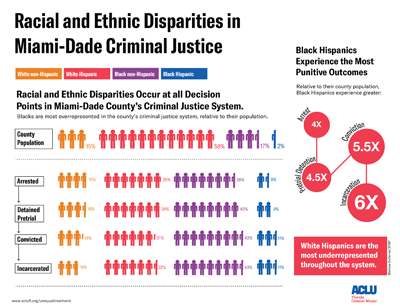
PIMARY FINDINGS
OVERREPRESENTED
Black defendants (regardless of ethnicity) are overrepresented in Miami-Dade County’s criminal justice system relative to their population share.
Racial and ethnic disparities occur at all decision points in Miami-Dade County’s criminal justice system.
ARREST /DETENTION /CONVICTION
Black defendants, whether Hispanic or non-Hispanic, are disproportionately arrested and, once in the system, are more likely than White defendants to suffer:
- longer periods of pretrial detention
- greater rates of pretrial detention, conviction, and incarceration
PUNITIVE
Black defendants who are Hispanic are most overrepresented and experience the most punitive outcomes at nearly every decision point in the system.
PROPORTIONATE
White defendants who are not Hispanic are proportionately represented in the county’s criminal justice system relative to their population share and experience the least punitive outcomes at nearly every decision point in the system.
PRISON TERMS
Black defendants who are not Hispanic are sentenced to longer prison terms than any other racial or ethnic group.
UNDERREPRESENTED
White defendants who are Hispanic are the most underrepresented in the system relative to their population share.
DISPROPORTIONATE
Black defendants who are not Hispanic are disproportionately represented in Miami-Dade County’s criminal justice system. Relative to their share of the county population, these defendants experience:
- 2.2 times greater rates of arrest
- 2.3 times greater rates of pretrial detention
- 2.5 times greater rates of conviction
- 2.5 times greater rates of incarceration
MOST DISPROPORTIONATE
Black defendants who are Hispanic are even more disproportionately represented in the county’s criminal justice system. Relative to their share of the county population, these defendants experience:
- 4.0 times greater rates of arrest
- 4.5 times greater rates of pretrial detention
- 5.5 times greater rates of conviction
- 6.0 times greater rates of incarceration
Racial and ethnic disparities also occur at the neighborhood level.
FILTERED OUT
White defendants, whether Hispanic or non-Hispanic, are more likely to be filtered out of the system early through prosecutorial decisions not to file or to reduce or drop charges, resulting in lower rates of conviction and incarceration for White defendants overall relative to Black defendants overall.
PUNISHMENT HOTSPOTS
When neighborhood is considered, these disparities persist. There are higher rates of arrest, pretrial detention, prosecution, conviction, and incarceration for defendants arrested in Black (Hispanic and non-Hispanic) neighborhoods, producing punishment “hotspots” in Black neighborhoods.
GEOGRAPHIC FUNNEL
These neighborhood disparities increase across each successive stage of the criminal justice system, thereby generating a “geographic funnel” for Black neighborhoods. This is especially true for Black Hispanic neighborhoods, although they represent a small fraction of neighborhoods in the county.
About the authors & research team
The report was written by Nick Petersen, Ph.D., and Marisa Omori, Ph.D., both assistant professors of sociology at the University of Miami. Assisting Petersen and Omori was their research team of graduate students, including Roberto Cancio, Oshea Johnson, Rachel Lautenschlager, and Brandon Martinez.
Related content


Keohane v. Dixon
December 13, 2024
Incarceration Should Not be a Death Sentence for Individuals Who...
November 25, 2024
Biden Must Use Final Months in Office to Commute Federal Death...
November 14, 2024
Donald Trump Will Return to the White House in January. The ACLU is...
November 7, 2024
How the ACLU Will Fight Four More Years of Trump
November 6, 2024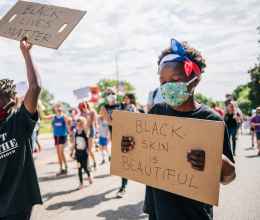
Extreme Abortion Bans Continue a Cruel Legacy of Controlling and...
November 5, 2024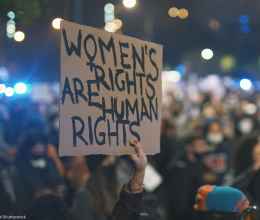
Abandoned But Unbroken: Defending Reproductive Justice for All
October 30, 2024
